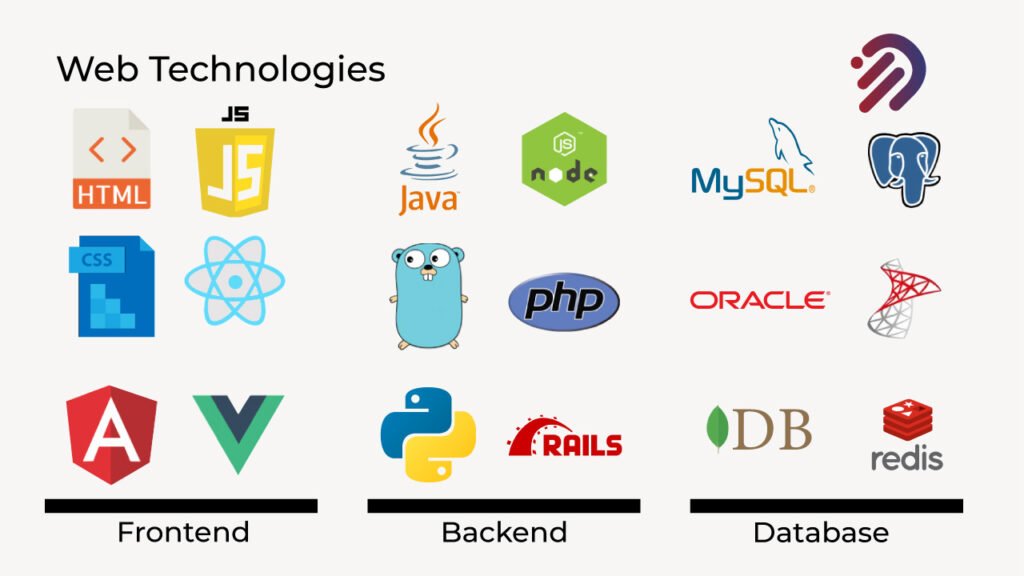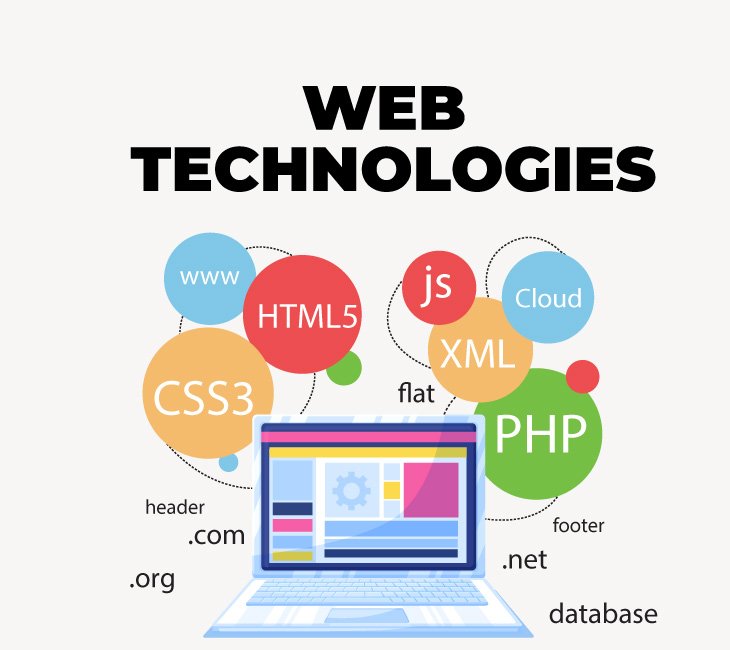In this article, we have only explained the generic Web technologies, which can be used to build any Web application
Common Web Technologies:
Front-End Web Technologies:
HTML
Let’s talk about the web technologies that are used to develop each of these Web application layers. For the front end, we use HTML, the HTML is used to create the UI markup. That means, an HTML markup decides how your UI should look, which button should go where, which section should go where, where you need to display your navigation bar, where you need to put your images, and all these things are decided by the HTML. For client-side computation or for front-end logic.

CSS
Then we use CSS, the CSS is used to give your HTML markup, some style. So, if you only use HTML without CSS, then your UI will look like this. But if you see CSS, then you can improve your user experience by creating some nice UI like this. So, these are the core technologies that are used to design and build your front end. Apart from these core technologies, there are a lot of frameworks out there in the market that make your job easier to build your front end.
JavaScript
we use JavaScript, so JavaScript gives your HTML pages some dynamic behavior. So, this means, if I click on a button, I can use my JavaScript to make some things happen. So, let’s say with a click of a button, I want to show a pop-up, then JavaScript can be used there.
React
One such framework is React, which is a very popular framework to build your front end. React was used to build the Facebook front end and later Facebook open-sourced the React framework and since then, this is the most popular front-end framework out there in the market.
Angular
Like React, we have Angular from Google, which also kind of gives you the same flexibility to design and build your front end.
Vue
We also have Vue.js, which is one more framework to build and design your front end, and the list goes on.
There are tons and tons of front-end frameworks out there in the market, each with its own features and capabilities.
Back-End Web Technologies:
Now let’s talk about the Back end.
Java
To build your back end, you can use Java, which is again, a widely popular language it’s been there for ages, and it’s so much mature that you can do almost everything with Java.
Node.JS
Then we have Node.js which is based on JavaScript. So, if you know JavaScript, then you can build your front end as well and your back end as well.
Go Language
We also have the Go language, which is getting more popular each day and has its unique features you can also use the Go language to build your back end.
PHP
We also have PHP and it’s also a mature framework or mature language, and it’s been there for ages. Most of the blogs that you see out there, they are based on WordPress, which uses PHP as its server-side language.
Python
Then we have Python. So, Python can also be used to design your back-end APIs or to design your back-end logic. Mostly Python is being used for data science functionality because it’s a very powerful language to build a web application for AI or data science Analytics.
Ruby on Rails
We have Ruby on Rails as well. Ruby is a general-purpose programming language that has groomed syntax and doesn’t require colossally extra punctuation. Ruby is streamlined compared to Java as it does not necessitate extensive codes to create basic structures such as data fields. Also, Ruby eases the task of using high-level abstractions such as metaprogramming
And again, here as well, the list goes on. There are so many languages out there and you can choose anyone.
Back-End Database Technologies:
Now let’s talk about our database technologies, the database technologies can be of two types, the SQL database or NoSQL database.
What are SQL Databases:
The SQL database stores your data in a tabular format where you can have relationships with multiple tables as well. SQL databases are great for storing large amounts of data. However, because SQL requires you to define the structure before using it can be restrictive and complicated when trying new things with your database since all updates must happen on an existing record or in one specific place depending on how much space has already been used up by other variables that don’t change often enough such as gender earnings brackets etc… But there is another side effect about which we should briefly speak: although these systems do require some setup time investment upfront, they make sure everything fits together perfectly so any alterations won’t cause chaos within our system – instead giving us complete flexibility without worrying too
What are NoSQL Databases:
Where the NoSQL database stores your data in JSON format. The flexibility of NoSQL databases means they can store any type or shape of data. They’re also optimized for performance, and scale well with lots and types (hint: you don’t need structure first!) while remaining simple enough not to be overwhelmed by all those options – perfect if your application needs something quick!
SQL Databases:
MySQL here is a SQL database and is widely popular. It’s also open source, so you can start using it in your projects. Similar to MySQL, we have PostgreSQL, which is also a SQL database and this is also an open-source database.
Then we have Oracle, which is again a widely popular database and is being used by most of the big organizations because of its capability to handle large data.
We also have SQL Server from Microsoft, which is a competition to Oracle.
NoSQL Databases:
Now, let’s talk about some of the NoSQL databases.
So, we have MongoDB, so, MongoDB stores your data in JSON format rather than in tabular format, and this one also is a popular database.
Then we have Redis, which is a cache-based database. So, this means it stores your data in a cache, so the input-output operation in a Redis database is much faster than any of the other databases but it comes with its own cost.
So, there are tons of database technologies out there and you can pick any of these technologies. If you have any comments or feedback do share them with me at yousuf@infotechabout.com






